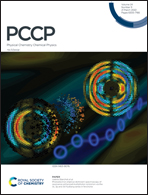Effects of transition metal doping on electronic structure of metastable β-Fe2O3 photocatalyst for solar-to-hydrogen conversion†
Abstract
Metastable β-Fe2O3 is a promising photocatalyst with a band gap of approximately 1.9 eV, while its intrinsic material properties remain rarely studied by theoretical calculations. Here, using density functional theory, we studied the electronic band structure and effective mass of carriers in Zr, Sn, and Ti doped β-Fe2O3. The calculation results show that, through the doping of Zr, Sn, or Ti, the dipole moment of FeO6 octahedra in β-Fe2O3 increases, which favors the separation of photo-excited electron–hole pairs. The electron and hole effective masses in the close-packed orientation [111] in cubic β-Fe2O3 have the smallest absolute values. After doping with Zr, Sn, and Ti, the absolute values of electron and hole effective masses in the [111] orientation are further reduced. Furthermore, the relative ratio (D) mostly became larger after doping with Zr, Sn, and Ti, which indicates that the photoexcited carriers in the doped structure are effectively separated. Construction of Zr, Sn, and Ti doped β-Fe2O3 in the [111] orientation may be effective to improve the photocatalytic efficiency.



 Please wait while we load your content...
Please wait while we load your content...